13 SMALL BIRDS With RED HEAD (ID Guide With Photos)
Did you recently come across a small red headed bird in your backyard, and want to know what species it was?
Identifying small birds with red feathers on their head is not as easy as it might seem, since there are many species of birds in North America that fit this description.
To help you identify the bird you saw, we’ll cover all the small red headed birds of North America.
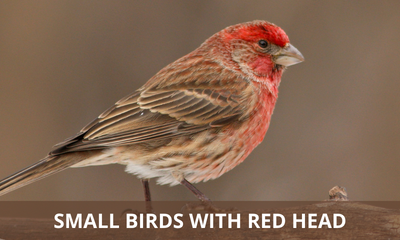
What small birds have red heads?
There are 13 types of small birds in North America that have a red head, which are covered in full detail below.
House Finch
Scientific name: Haemorhous mexicanus
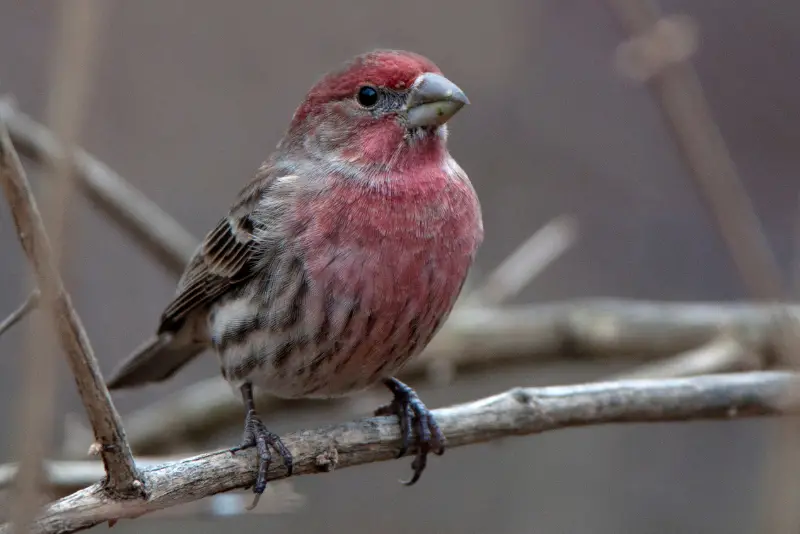
House Finches are common birds throughout North America, and are mostly found in settled areas, ranging from rural towns to large metropolitan centers.
Adult male House Finches can be identified by their bright red head and breast, although in some cases they are slightly more orange or yellowish in color.
The females lack any red coloration, and instead have grayish streaks on a brown background.
The House Finch was originally a western bird, and it wasn’t until the 1940s that this bird was discovered in New York and other places on the east coast of the US.
These small finches are the most common red headed birds In North America
The eastern House Finch population began to grow in the 1950s and 60s, and by the year 2000, it had expanded so far west that it connected with the original western population.
The House Finch is entirely herbivorous, and feeds on seeds, buds, and fruits.
If you set up a backyard feeder, you can expect House Finches to be among the first birds to visit it.
The House Finch is found in the US all year round, and while it is not a migratory bird, it does move to areas with more food outside of the breeding season.
Cassin’s Finch
Scientific name: Haemorhous cassinii
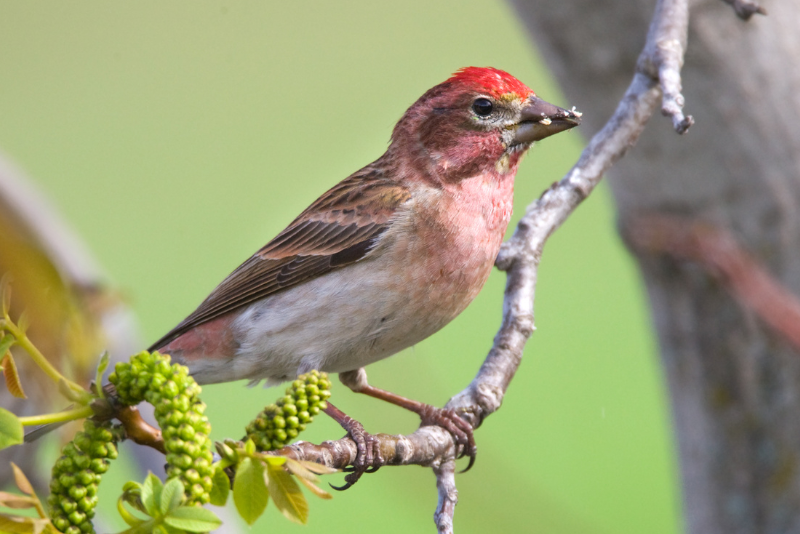
The Cassin’s Finch is another small red headed finch, but is mostly found at higher altitudes than the House Finch.
Adult males have a bright red crest, chest, throat, and rump. Their neck and back are streaked brown, and their wings are somewhat darker with two pink wingbars and pale margins.
Adult females and juveniles lack the reddish color and instead are brown with dark streaks on top and slightly darker wings with two pale wingbars.
The Cassin’s Finch prefers coniferous forests and can be seen all year in mountainous habitats of North America.
Outside of the breeding season, it forms flocks and sometimes visits lower elevations and more southern latitudes, especially in cold winters.
Purple Finch
Scientific name: Haemorhous purpureus

The Purple Finch is a little songbird with a compact body, a conical beak, and a red head that is disproportionately larger than its body.
The heads and breasts of adult males are a deep shade of raspberry red, while the backs of their bodies are streaked with red and brown. The flanks are cream colored with pink streaks.
Birds from the eastern part of the range have a white belly, whereas birds from the western part of the range have a gray belly.
The upperparts of females and immature birds are streaked with a grayish brown, while the underparts are a light cream color with brown streaks.
During the months of May through August, the Purple Finch is found breeding in northern parts of North America.
During the winter, however, these birds migrate south and spend the cold months in the eastern United States.
Northern Cardinal
Scientific name: Cardinalis cardinalis
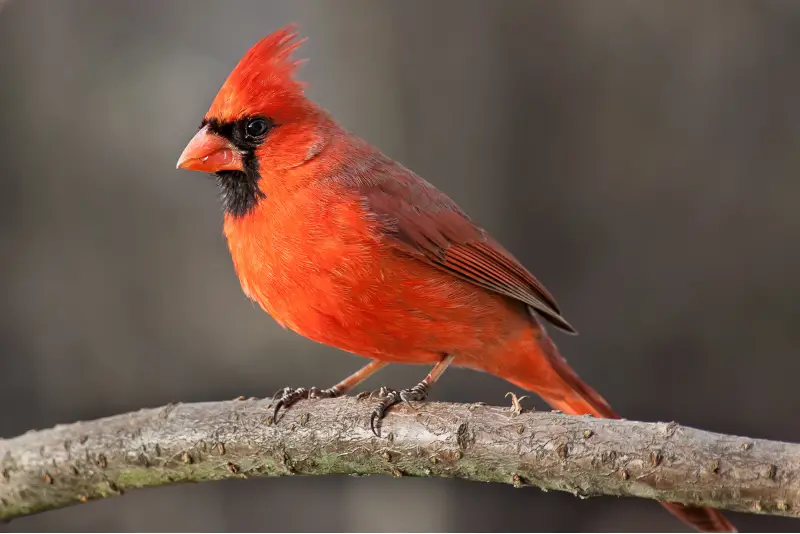
The Northern Cardinal is one of the most well known red birds in North America, and is a common breeding bird in backyards and open woodland.
Male Northern Cardinals have a brilliant red head and chest, with a slightly darker red on their back and wing feathers.
In addition, the face has a black mask extending from the bright red bill to the throat.
Female Northern Cardinals are not quite as colorful as males, and have a more buff-brown body color with some reddish tinges, although they also have a bright red bill.
During the winter months it doesn’t defend its territory, and sometimes gathers in flocks of up to 25 individuals that feed together. This bird is a regular visitor at bird feeders.
Scarlet Tanager
Scientific name: Piranga olivacea
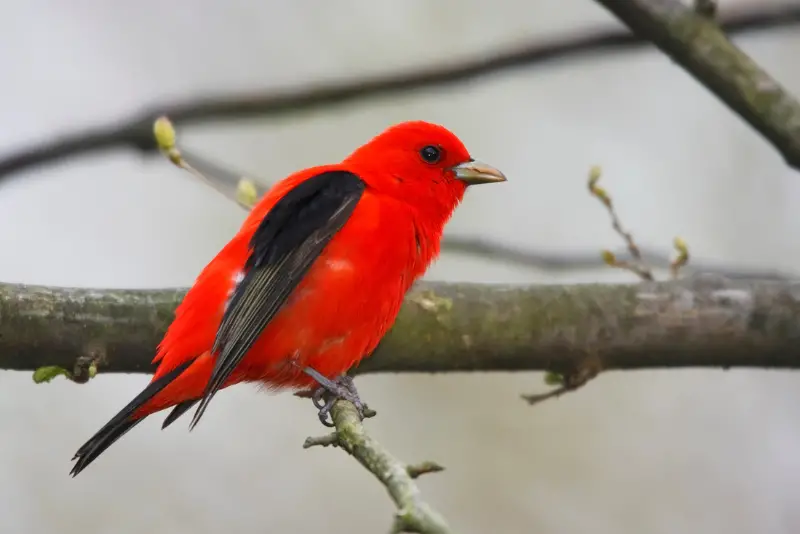
The Scarlet Tanager is a bird with a tropical appearance, due to the bright scarlet plumage of the males, which contrasts with their coal-black wings and tail feathers.
But unlike the vibrant red color of the male, the female looks more like a pale yellow bird.
This little bird is a summer visitor in North America, and spends its winter in Central and South America.
Both sexes sing a similar song in order to mark and defend their territory from other Tanagers.
These birds love warm temperatures, and thus arrive late in spring, and leave early in fall. During spring and fall, Scarlet Tanagers from Canada can be seen passing through North America.
Scarlet Tanagers are insectivores, and feed on spiders and flying insects (including bees and wasps) high up in tree canopies.
In late summer, they are also partial to berries, such as blackberries, strawberries, raspberries, juneberries and mulberries, and having these plants in your garden is a great way to attract them.
Western Tanager
Scientific name: Piranga ludoviciana
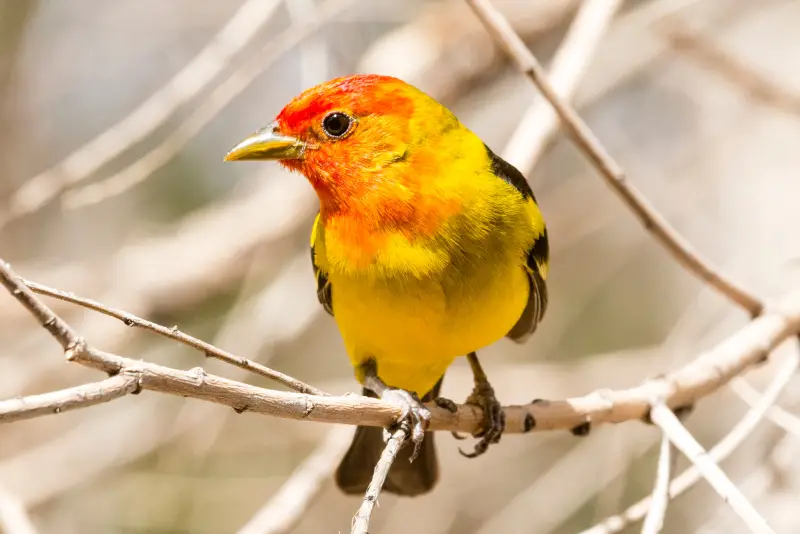
With its brilliant hues, male Western Tanagers are difficult to overlook.
Adult males have bright red heads and throats, while their back, tail, and wings are black with two yellow and white wingbars.
Females and juvenile birds have a similar appearance, but the yellow is duller and the red color is almost absent, with the exception of a speck near the base of the beak.
The Western Tanager may be seen in North America during the breeding season from May to August. These exotically colored birds spend the remainder of the year in Central America.
Red Crossbill
Scientific name: Loxia curvirostra
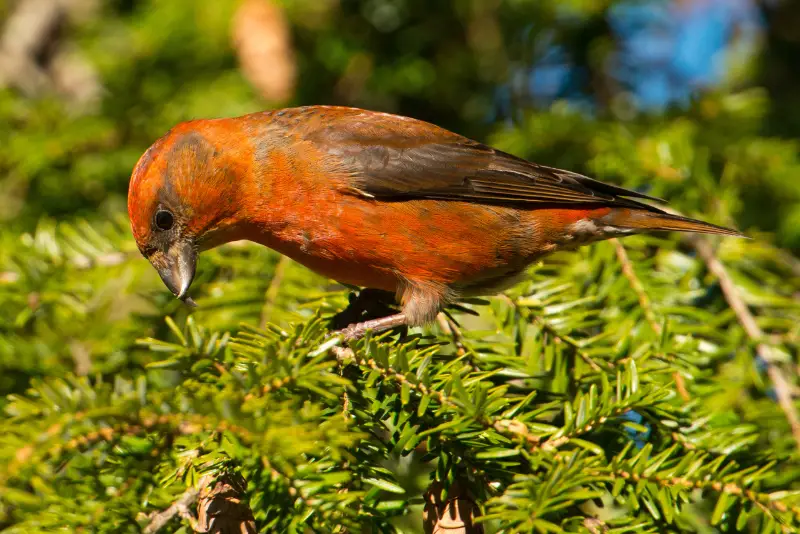
These birds get their name from their distinctive bills, which resemble a bent pair of scissors with their points crossed.
Adult males have a deep red head, underside, and rump, while their wings and back are dark brown
Females and immature Red Crossbills are more inconspicuous, and are olive-colored with reddish streaks on their flanks and belly.
Red crossbills are able to harvest seeds from pine cones by cutting through the scales of the cones with their crossbill.
They will use their feet to keep the cones pinned down while they use their tongues to pick the seeds out of the cones and then eat them.
These birds breed in Canada and northern parts of the USA, and only show up as winter visitors in more southern states.
The breeding season of these crossbills is timed to coincide with ripening of pine or spruce cones, and can sometimes start as early as February.
Pine Grosbeak
Scientific name: Pinicola enucleator

The Pine Grosbeak is a little songbird with a short and stubby bill.
The adult males are red with varying amounts of gray on their sides and bellies. The tail and the wings are dark with two white wing bars.
Females are more drab, and have a more brownish yellow coloration compared to the males.
This bird breeds in the mountainous regions of North America, where it is a year-round resident.
During the cold season, there is an influx of northern Pine Grosbeaks that spend the winter in the United States.
Common Redpoll
Scientific name: Acanthis flammea
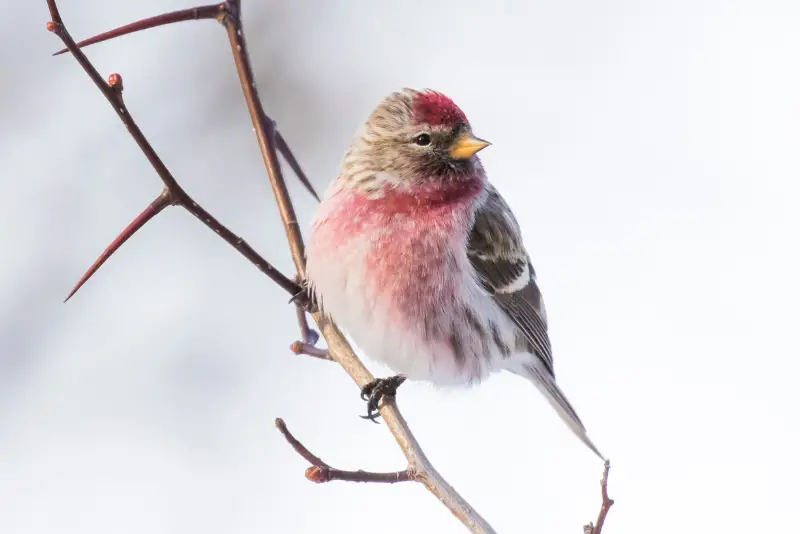
The Common Redpoll is a small finch of northern forests. It is a breeding bird throughout Canada, and is a winter visitor in the US, where it is more common during irruptive years.
Adult males have a gray-brown head with a red forehead, as well as a pinkish red breast and flanks.
Female Common Redpolls are less colorful, but they also have a red forehead. Both sexes have brown-gray upperparts with dark streaks.
This red-headed bird favors boreal forests all the way north to the arctic.
Outside of the breeding season this small bird forms small flocks that move around in search of areas with plentiful seeds.
Red-headed Woodpecker
Scientific name: Melanerpes erythrocephalus
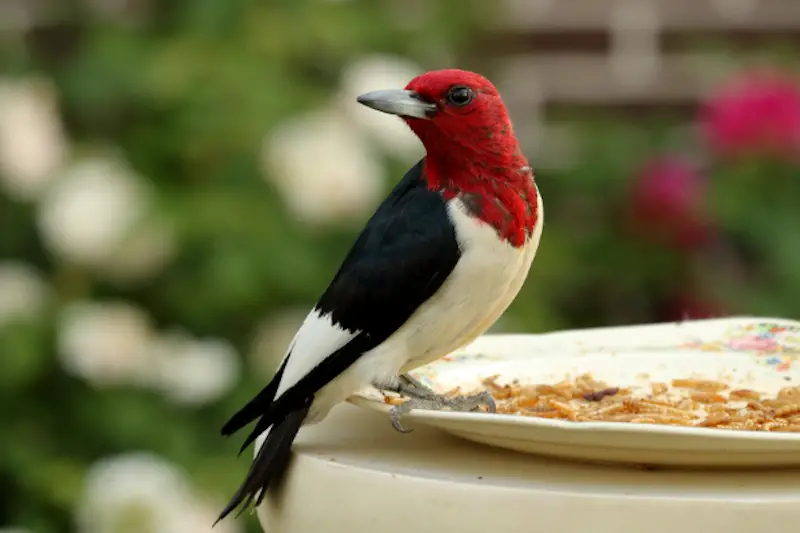
The Red-headed Woodpecker is one of the few non-dimorphic woodpeckers, which means that males and females look alike.
Red Headed Woodpeckers have an all-red head with a solid black back. They also have a white chest, rump and belly, as well as black wings and a black tail. The bill and legs are gray.
The Red-Headed Woodpecker favors wide-open deciduous or coniferous forest habitats, or forests with plenty of dead or rotten limbs.
It may use the same nest cavity for multiple years in a succession, in contrast to other woodpeckers that only use them once or for a small period of time.
This woodpecker used to be common throughout North America, but the population has unfortunately declined by more than 90 percent, and the Red-headed Woodpecker is now a rare sight in many parts of the US.
Red-bellied Woodpecker
Scientific name: Melanerpes carolinus
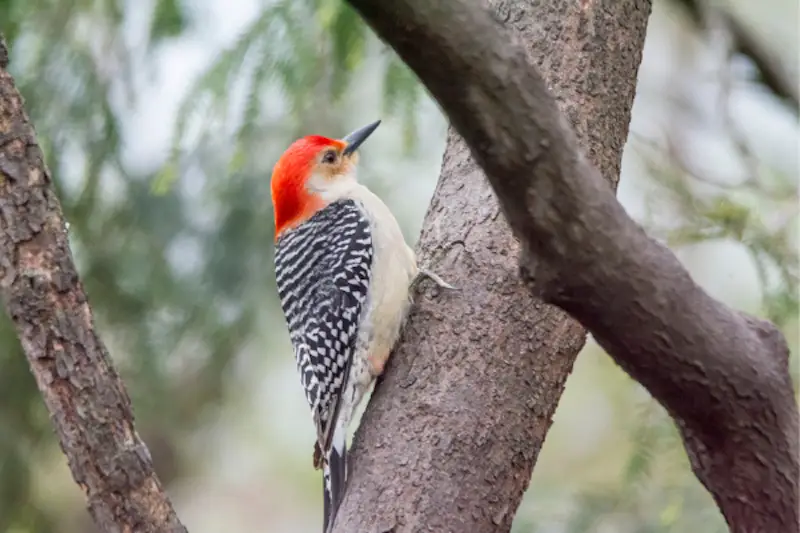
The Red-bellied Woodpecker has a black-and-white “Zebra” pattern on its back, as well as a white rump.
Males have a red crown that goes all the way down to the base of the neck. Both sexes look similar, but the female lacks the red cap on its head.
The Red-bellied Woodpecker favors shady woodlands, forest edges and backyards with old trees.
It excavates holes in rotting wood to locate beetles, centipedes, spiders, and other creatures.
During winter, this bird with red head stores berries and acorns in tree crevices and cracks. Every year, the Red-bellied Woodpecker excavates a new nest below the previous one in the same tree.
While this small woodpecker is named for the reddish hue on its belly, this can be hard to see unless you get a close up view.
Fortunately, this beautiful bird is steadily expanding its range across the whole country.
Red-naped Sapsucker
Scientific name: Sphyrapicus nuchalis
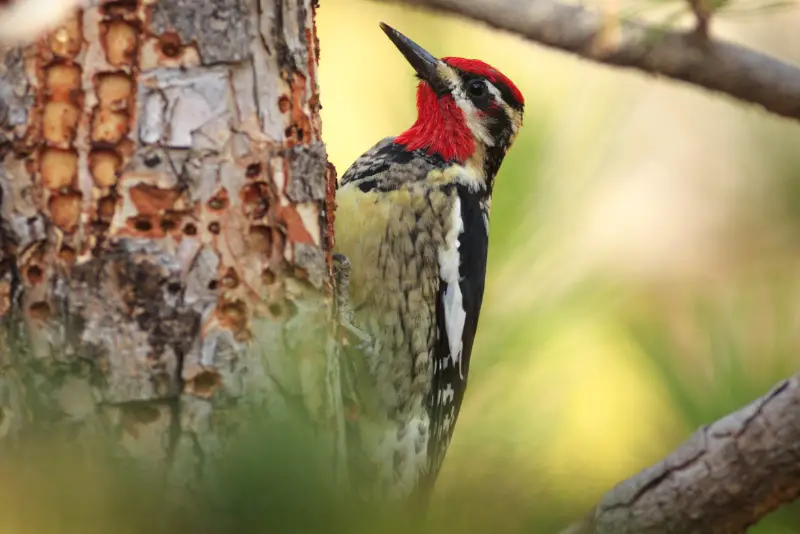
The Red-naped Sapsucker is a small woodpecker species with striking red coloration on the head. Adult birds have a bright red nape plus a red throat.
The partially red coloration on their head makes it easy to tell them apart from Red-breasted Sapsuckers, which have completely red colored heads.
The Red-naped Sapsucker is a breeding bird in the mountains of North America, and is more common during the winter months, when there is an influx of wintering birds from Canada.
Anna’s Hummingbird
Scientific name: Calypte anna
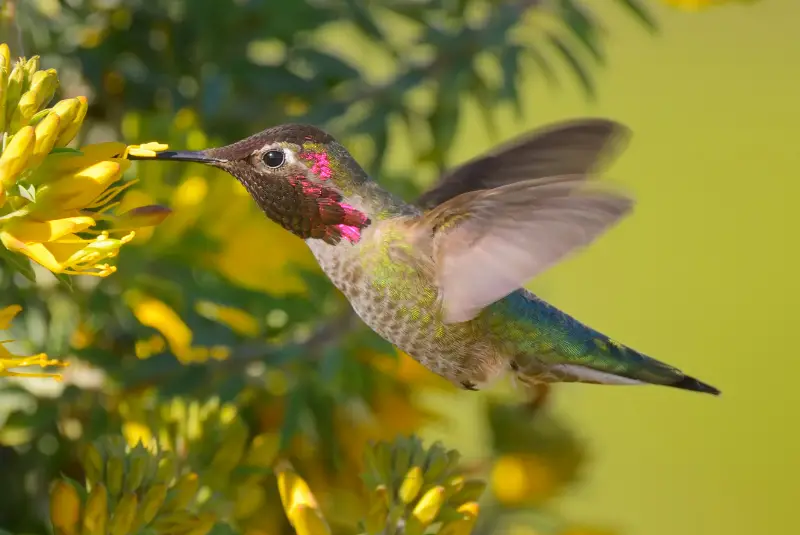
A compact Calypte hummingbird species that thrives in human habitats, Anna’s Hummingbird is a small hummingbird species
This intrepid hummingbird has steadily and relentlessly increased its breeding range since the early 1900’s, spreading from coastal California to more interior regions of the continent.
This small hummingbird has a reddish purple head
And as part of this expansion of its range, Anna’s Hummingbird has colonized urban areas in other desert states of the southwestern United States.
This tiny bird is now a common backyard bird in the southwest, where it nests in gardens, parks, and other urban areas.
Anna’s Hummingbirds are highly adaptive when foraging for food, and are able to utilize a broad range of nectar sources, including flowering trees and shrubs from different continents.
Red-faced Warbler
Scientific name: Cardellina rubrifrons
The Red-faced Warbler is an elegant small songbird with a gray body that contrasts with a fire-engine red face and a black crown on top of the head. It also has a red patch on the back of its neck.
Found primarily in high-altitude coniferous forests, this eye-catching warbler prefers habitats characterized by a blend of pine and oak trees in mountains and canyons.
The Red-faced Warbler is a summer visitor in Arizona and New Mexico, where it can be encountered breeding from May through September.
These warblers have noteworthy nesting habits: unlike many other birds, they build their nests on the ground in small depressions.
Final remarks
In summary, these are the 13 small species of birds with red head in North America:
- House Finch
- Cassin’s Finch
- Purple Finch
- Northern Cardinal
- Scarlet Tanager
- Western Tanager
- Pine Grosbeak
- Red Crossbill
- Common Redpoll
- Red-headed Woodpecker
- Red-naped Sapsucker
- Anna’s Hummingbird
- Red-faced Warbler
If you’ve spotted one of these birds with red head while bird watching in your backyard, hopefully this ID guide will help you identify it quickly and easily.
And if you enjoyed this article, check out our guide to the red birds of Texas.
